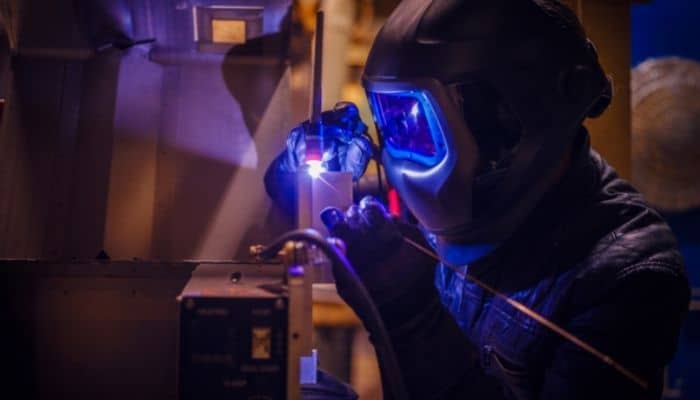Quick Answer: How to Buy the Right TIG Welder?
The most important features on a TIG welder are amperage range, arc stability, power output, and duty cycle. Other features are more important for professionals, such as pulse rating and cooling. The price you pay will depend heavily on the additional features you require, so be sure to know which ones you need.
If you are looking to buy a new TIG welder you might be confused by all the options and features that are available. It can be difficult to know what features you will need and whether they are worth the extra cost.
This guide will explain everything you should consider when buying a TIG welder to help you make the right buying decision.
How To Choose The Right TIG Welder
The following sections outline all of the most important features to consider when buying a TIG welder.
Amperage Range
The first consideration when buying a TIG welder is the amperage range. The amperage range dictates which materials you can weld.
If you get a TIG welder with a narrow amperage range then you will be limited to certain materials. A range of 5 amps to 200 amps will allow you to weld anything from ¼” aluminum to 20-gauge steel.
Amperage under around 200 amps means you will be limited to 1/8” or thinner if you are welding aluminum.
When tackling the thinnest metals, you will need a low amperage. TIG welders that start at 10-15 amps can warp materials that are too thin.
Low Amperage Stability
Arc stability at low amperage proves crucial when you are welding thin metals.
Stability at low amperage allows for easier starting, improved crater filling, and better heat control.
AC vs DC vs AC/DC
The power supply type has a direct effect on the materials that you can weld with a TIG welder.
For applications requiring the joining of steel or stainless steel, you will only ever need a DC welder. These metals do not oxidize enough during the process to necessitate AC output, so DC proves more efficient.
However, metals that undergo rapid oxidization will require an AC compatible welder. Metals that require AC output include aluminum and magnesium.
If you know exactly what materials you will be welding, then it is simply a case of matching the power output to those materials.
However, if you are working with a range of different materials, or you are unsure about what materials you will need to work with in the future, it is well worth finding an AC/DC combination welder.
AC/DC TIG welders are compatible with both current types, offering you greater flexibility.
Pulse Rating

Managing heat during a weld is vital to producing a clean join. For that reason, many welders look for the ability to perform pulsed welding.
TIG welders with pulse capabilities are common. They are most often used for thin materials that might warp or break under the stress of standard welding techniques.
The number you should look for is pulses per second. Modern TIG welders are rated up to around 5000 pulses per second, which should be enough for any application.
A high pulse rating is essential for applications where the finish needs to be clean. It can also allow you to move more quickly, saving time if you are performing many welds.
Duty Cycle
The duty cycle of a TIG welder refers to the percentage of time you can use the welder for without stopping to allow it to cool.
It is expressed as a percentage of each 10 minutes, usually at a specified amperage. For example, a TIG welder with a duty cycle of 40% can be used for 4 minutes before requiring a 6-minute rest to cool down.
The higher the duty cycle at the amperage you require the more suitable it is for intensive or commercial applications. Look for a duty cycle of at least 60-80%.
For light use or home applications, you are unlikely to need a high duty cycle and can safely avoid the extra expense. A duty cycle of 20% will usually suffice.
Cooling Type available
There are two cooling options for TIG welders – air-cooling and water cooling.
The standard system is air cooling and most of the time it does everything you need from it.
Water cooling proves useful when you are working at high power outputs or within constricted spaces. The temperature build-up can be overwhelming in these situations and you will wish you had a water cooling system.
Water-cooled torches are more suitable for fine work due to the smaller head.
Portability
Portability may be one of the more important factors when it comes to choosing a TIG welder.
A crucial part of portability is the weight. Portable welders weigh around 40-50 pounds, which makes them suitable for taking with you on a job or for easy transport around your workshop.
Larger models can weigh in the region of 100 pounds, sometimes even more than that. Weighty models like these are not suitable if you require portability and can only be moved around the workshop if you have a suitable cart.
The price you pay for portability can be a shorter duty cycle.
Ease of Use
There are several additional ease of use features you might look for on a more advanced model.
Digital controls allow you to adjust various settings, including amperage and pulse rate, with high precision.
You can achieve the same results with an analog welder, but it is much easier with a digital welder.
A major advantage of digital control is the ability to switch between presets if you are performing different welding tasks.
Another important ease of use feature is the foot pedal. You need both hands to perform the weld, so having a foot pedal to control the amperage is vital if you want full control.
A comfortable foot pedal should be at a reasonable angle from the ground so that you do not suffer from pedal fatigue from prolonged use.
Additional Welding Options
Some TIG welders come with stick welding and plasma cutting capabilities.
If you need these capabilities but do not want to buy additional equipment, you can gain all the versatility you need by looking for this type of TIG welder.
However, if you are unlikely to need these capabilities then they might not be worth the additional price tag.
Price
There is a wide range of price points for TIG welders. Whatever budget you have, there will be a suitably priced model for you.
Affordable TIG welders start at just under $300. For example, a Yeswelder budget model comes in at around $270.
A more advanced, professional model from Miller Electric, the Dynasty 210 series, could set you back more than $6000.
A portable model from Lincoln Electric sits in the middle with an asking price of around $1800.
In general, every feature we have mentioned adds a little to the price. You will also pay extra for recognizable brand names, though in return you get peace of mind that the machine is well built.
Summary
We hope this guide has helped you to understand all the options available to you when buying a TIG welder. Whatever your budget, you should be able to find a suitable model for your next welding project.
If you have any questions or comments about this guide or TIG welders in general, please feel free to leave them in the comments section below.


